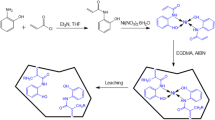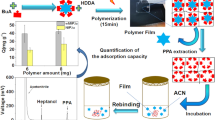Abstract
Atrazine (ATZ) is one of the most widely used triazine herbicides in the world; it is highly toxic and poses a risk to environmental balance and human health. Therefore, its detection and monitoring of allowed concentrations are vital, preferably using simple and relatively low-cost analytical methods. Molecularly imprinted polymers (MIPs) are synthetic structures containing imprinted nanocavities that can specifically bind to their target with high sensitivity, selectivity, and viability. In this work, MIPs were synthesized by the precipitation method, using methacrylic acid as a functional monomer, ethylene glycol dimethacrylate as a crosslinker, and atrazine as a template molecule in a single polymerization step, unlike other complex methodologies reported in the literature. For comparison purposes, NIP (non-imprinted polymer) was prepared. MIPs and NIPs were characterized using infrared spectroscopy (FT-IR) and scanning electron microscopy (SEM). Through cyclic voltammetry (CV) and differential pulse (DP), atrazine was detected in an accurate spring water sample containing 1 to 100 ppb of the herbicide. The limit of detection (LOD) found was 0.02. Therefore, it was possible to synthesize an efficient MIP for detecting atrazine in spring water through a simple methodology.









Similar content being viewed by others
Data availability
Data will be made available on request.
References
Dias ACL, Santos JMB, Santos ASP et al (2018) Ocorrência de Atrazina em águas no Brasil e remoção no tratamento da água: revisão sistemática. Revista Internacional de Ciências 8:149–168. https://doi.org/10.12957/ric.2018.34202
Salahshoor Z, Ho K-V, Hsu S-Y et al (2022) Detection of atrazine and its metabolites by photonic molecularly imprinted polymers in aqueous solutions. Chem Eng J Adv 12:100368. https://doi.org/10.1016/j.ceja.2022.100368
Fang L, Jia M, Zhao H et al (2021) Molecularly imprinted polymer-based optical sensors for pesticides in foods: recent advances and future trends. Trends Food Sci Technol 116:387–404. https://doi.org/10.1016/j.tifs.2021.07.039
He B, Ni Y, Jin Y, Fu Z (2020) Pesticides-induced energy metabolic disorders. Sci Total Environ 729:139033. https://doi.org/10.1016/j.scitotenv.2020.139033
Chang J, Fang W, Chen L et al (2022) Toxicological effects, environmental behaviors and remediation technologies of herbicide atrazine in soil and sediment: a comprehensive review. Chemosphere 307:136006. https://doi.org/10.1016/j.chemosphere.2022.136006
Chen Q, Lu H, Zhang Z et al (2022) Visible-light-driven molecularly imprinted self-powered sensor for atrazine with high sensitivity and selectivity by separating photoanode from recognition element. Sens Actuators B Chem 360:131670. https://doi.org/10.1016/j.snb.2022.131670
Purcell M, Neault JF, Malonga H et al (2001) Interactions of atrazine and 2,4-D with human serum albumin studied by gel and capillary electrophoresis, and FTIR spectroscopy. Biochimica et Biophysica Acta (BBA) - Protein Struct Mol Enzymol 1548:129–138. https://doi.org/10.1016/S0167-4838(01)00229-1
Brasil (2011) Ministério da Saúde. Portaria n.o 2.914, de 12 de dezembro de 2011. Dispõe sobre os procedimentos de controle e de vigilância da qualidade da água para consumo humano e seu padrão de potabilidade 1:39–46
Graziano N, McGuire MJ, Roberson A et al (2006) 2004 national atrazine occurrence monitoring program using the abraxis ELISA method. Environ Sci Technol 40:1163–1171. https://doi.org/10.1021/es051586y
Coelho ERC, Di BL (2017) Presença e remoção de atrazina, desetilatrazina, desisopropilatrazina e desetilhidroxiatrazina em instalação piloto de ozonização e filtração lenta. Eng Sanit Ambient 22:789–796. https://doi.org/10.1590/s1413-41522017147638
World Health Organization (2022) Guidelines for drinking water quality. In: Fourth edition incorporating the first and second Adenda. Avaliable in https://www.who.int/publications/i/item/9789241549950
Er EÖ, Çağlak A, Engin GÖ, Bakirdere S (2019) Ultrasound-assisted dispersive solid phase extraction based on Fe3O4/reduced graphene oxide nanocomposites for the determination of 4-tert octylphenol and atrazine by gas chromatography–mass spectrometry. Microchem J 146:423–428. https://doi.org/10.1016/j.microc.2019.01.040
Bexfield LM, Belitz K, Lindsey BD et al (2021) Pesticides and pesticide degradates in groundwater used for public supply across the United States: occurrence and human-health context. Environ Sci Technol 55:362–372. https://doi.org/10.1021/acs.est.0c05793
Wang S, Salamova A, Venier M (2021) Occurrence, spatial, and seasonal variations, and gas–particle partitioning of atmospheric current-use pesticides (CUPs) in the Great Lakes basin. Environ Sci Technol 55:3539–3548. https://doi.org/10.1021/acs.est.0c06470
Hama JR, Kolpin DW, LeFevre GH et al (2021) Exposure and transport of alkaloids and phytoestrogens from soybeans to agricultural soils and streams in the Midwestern United States. Environ Sci Technol 55:11029–11039. https://doi.org/10.1021/acs.est.1c01477
Qu M, Liu G, Zhao J et al (2020) Fate of atrazine and its relationship with environmental factors in distinctly different lake sediments associated with hydrophytes. Environ Pollut 256:113371. https://doi.org/10.1016/j.envpol.2019.113371
Ronkainen NJ, Halsall HB, Heineman WR (2010) Electrochemical biosensors. Chem Soc Rev 39:1747. https://doi.org/10.1039/b714449k
Wongkaew N, Simsek M, Griesche C, Baeumner AJ (2019) Functional nanomaterials and nanostructures enhancing electrochemical biosensors and lab-on-a-chip performances: recent progress, applications, and future perspective. Chem Rev 119:120–194. https://doi.org/10.1021/acs.chemrev.8b00172
Basak S, Venkatram R, Singhal RS (2022) Recent advances in the application of molecularly imprinted polymers (MIPs) in food analysis. Food Control 139:109074. https://doi.org/10.1016/j.foodcont.2022.109074
Vasapollo G, Del SR, Mergola L et al (2011) Molecularly imprinted polymers: present and future prospective. Int J Mol Sci 12:5908–5945. https://doi.org/10.3390/ijms12095908
Mahmoudpour M, Torbati M, Mousavi M-M et al (2020) Nanomaterial-based molecularly imprinted polymers for pesticides detection: recent trends and future prospects. TrAC, Trends Anal Chem 129:115943. https://doi.org/10.1016/j.trac.2020.115943
Chen L, Wang X, Lu W et al (2016) Molecular imprinting: perspectives and applications. Chem Soc Rev 45:2137–2211. https://doi.org/10.1039/C6CS00061D
Azizi A, Shahhoseini F, Langille EA et al (2021) Micro-gel thin film molecularly imprinted polymer coating for extraction of organophosphorus pesticides from water and beverage samples. Anal Chim Acta 1187:339135. https://doi.org/10.1016/j.aca.2021.339135
Kumar V, Kim K-H (2022) Use of molecular imprinted polymers as sensitive/selective luminescent sensing probes for pesticides/herbicides in water and food samples. Environ Pollut 299:118824. https://doi.org/10.1016/j.envpol.2022.118824
Pardieu E, Cheap H, Vedrine C et al (2009) Molecularly imprinted conducting polymer based electrochemical sensor for detection of atrazine. Anal Chim Acta 649:236–245. https://doi.org/10.1016/j.aca.2009.07.029
Zhao B, Feng S, Hu Y et al (2019) Rapid determination of atrazine in apple juice using molecularly imprinted polymers coupled with gold nanoparticles-colorimetric/SERS dual chemosensor. Food Chem 276:366–375. https://doi.org/10.1016/j.foodchem.2018.10.036
Azizi A, Bottaro CS (2020) A critical review of molecularly imprinted polymers for the analysis of organic pollutants in environmental water samples. J Chromatogr A 1614:460603. https://doi.org/10.1016/j.chroma.2019.460603
Metwally M, Benhawy A, Khalifa R et al (2021) Application of molecularly imprinted polymers in the analysis of waters and wastewaters. Molecules 26:6515. https://doi.org/10.3390/molecules26216515
Pichon V, Chapuis-Hugon F (2008) Role of molecularly imprinted polymers for selective determination of environmental pollutants—a review. Anal Chim Acta 622:48–61. https://doi.org/10.1016/j.aca.2008.05.057
Chen L, Xu S, Li J (2011) Recent advances in molecular imprinting technology: current status, challenges and highlighted applications. Chem Soc Rev 40:2922. https://doi.org/10.1039/c0cs00084a
International Union of Pure and Applied Chemistry (2019) limit of detection. In: The IUPAC Compendium of Chemical Terminology, 3rd ed. International Union of Pure and Applied Chemistry (IUPAC), Research Triangle Park. Avaliable in https://goldbook.iupac.org/terms/view/L03540
Pavia DL, Lampman GM, Kriz GS, Vyvyan JR (2009) Introduction to spectroscopy, 4th edn. Brooks Cole Cengage Learning, Bellingham, Washington
de Alves LT, O, Erbetta CDC, Fernandes C, et al (2015) Síntese e caracterização de MIP com fenilalanina visando sua aplicação na técnica de SPE. Polímeros 25:596–605. https://doi.org/10.1590/0104-1428.2116
Adu AA, Neolaka YAB, Riwu AAP et al (2020) Synthesis, characterization and evaluation of swelling ratio on magnetic p53-poly(MAA-co-EGDMA)@GO-Fe3O4(MIP@GO-Fe3O4)-based p53 protein and graphene oxide from kusambi wood (Schleichera oleosa). J Market Res 9:11060–11068. https://doi.org/10.1016/j.jmrt.2020.08.003
Segatelli MGSV, ABT P, Yoshida IVP TC, (2010) Cadmium ion-selective sorbent preconcentration method using ion imprinted poly(ethylene glycol dimethacrylate-co-vinylimidazole). React Funct Polym 70:325–333. https://doi.org/10.1016/j.reactfunctpolym.2010.02.006
Lv YK, Wang LM, Yang L et al (2012) Synthesis and application of molecularly imprinted poly(methacrylic acid)-silica hybrid composite material for selective solid-phase extraction and high-performance liquid chromatography determination of oxytetracycline residues in milk. J Chromatogr A 1227:48–53. https://doi.org/10.1016/j.chroma.2011.12.108
Silverstein RM, Webster FX, Kiemle DJ (2005) Spectrometric identification of organic compounds, 7th edn. John Wiley & Sons INC.
de Ávila LG, Leite SB, Dick DP, Pohlmann AR (2009) Formulações de atrazina em xerogéis: síntese e caracterização. Quim Nova 32:1727–1733. https://doi.org/10.1590/S0100-40422009000700009
Che Lah NF, Ahmad AL, Low SC, Shoparwe NF (2019) The role of porogen-polymer complexation in atrazine imprinted polymer to work as an electrochemical sensor in water. J Environ Chem Eng 7:103500. https://doi.org/10.1016/j.jece.2019.103500
Xu Z, Kuang D, Liu L, Deng Q (2007) Selective adsorption of norfloxacin in aqueous media by an imprinted polymer based on hydrophobic and electrostatic interactions. J Pharm Biomed Anal 45:54–61. https://doi.org/10.1016/j.jpba.2007.05.024
Caro E, Marce R, Borrull F et al (2006) Application of molecularly imprinted polymers to solid-phase extraction of compounds from environmental and biological samples. TrAC Trends Anal Chem 25:143–154. https://doi.org/10.1016/j.trac.2005.05.008
Li S, Zhong T, Long Q et al (2021) A gold nanoparticles-based molecularly imprinted electrochemical sensor for histamine specific-recognition and determination. Microchem J 171:106844. https://doi.org/10.1016/j.microc.2021.106844
Liu G, Yang X, Li T et al (2015) Preparation of a magnetic molecularly imprinted polymer using g-C3N4–Fe3O4 for atrazine adsorption. Mater Lett 160:472–475. https://doi.org/10.1016/j.matlet.2015.07.157
Nsibande SA, Forbes PBC (2019) Development of a quantum dot molecularly imprinted polymer sensor for fluorescence detection of atrazine. Luminescence 34:480–488. https://doi.org/10.1002/bio.3620
Gkementzoglou C, Kotrotsiou O, Koronaiou M, Kiparissides C (2016) Development of a sandwich-type filtration unit packed with MIP nanoparticles for removal of atrazine from water sources. Chem Eng J 287:233–240. https://doi.org/10.1016/j.cej.2015.11.018
Kotrotsiou O, Chaitidou S, Kiparissides C (2009) Boc-l-tryptophan imprinted polymeric microparticles for bioanalytical applications. Mater Sci Eng C 29:2141–2146. https://doi.org/10.1016/j.msec.2009.04.014
Durai L, Badhulika S (2020) Highly selective trace level detection of Atrazine in human blood samples using lead-free double perovskite Al2NiCoO5 modified electrode via differential pulse voltammetry. Sens Actuators B Chem 325:128792. https://doi.org/10.1016/j.snb.2020.128792
AMC technical briefAMC (1994) Is my calibration linear? Analyst 119:2363. https://doi.org/10.1039/an9941902363
Traghetta DGVCMSCSVEM-NL (1996) Mecanismos de sorção da atrazina em solos: estudos espectroscópicos e polarográficos. Comunicado Técnico-EMBRAPA 14:1–7
Enoch RR, Stanko JP, Greiner SN et al (2007) Mammary gland development as a sensitive end point after acute prenatal exposure to an atrazine metabolite mixture in female Long-Evans rats. Environ Health Perspect 115:541–547. https://doi.org/10.1289/ehp.9612
Potter TL, Bosch DD, Dieppa A et al (2013) Atrazine fate and transport within the coastal zone in southeastern Puerto Rico. Mar Pollut Bull 67:36–44. https://doi.org/10.1016/j.marpolbul.2012.12.004
Solomon KR, Baker DB, Richards P et al (1996) Ecological risk assessment of atrazine in North American surface waters. Environ Toxicol Chem 15:31–76
Brasil (2006) Ministério da Saúde. Secretaria de Vigilância em Saúde. vigilância e controle de qualidade da água ara consumo humano 212. Avaliable in https://bvsms.saude.gov.br/bvs/publicacoes/vigilancia_controle_qualidade_agua.pdf
Xu S, Li J, Chen L (2011) Molecularly imprinted polymers by reversible addition–fragmentation chain transfer precipitation polymerization for preconcentration of atrazine in food matrices. Talanta 85:282–289. https://doi.org/10.1016/j.talanta.2011.03.060
Acknowledgements
The authors thank the National Council for Scientific and Technological Development (CNPq, 302661/2020-4) and Central Analytica-UFC (funded by Finep-CT-INFRA, CAPES-Pró-Equipamentos and MCTI-CNPq-SisNano2.0) by the microscopy measurements.
Author information
Authors and Affiliations
Corresponding author
Additional information
Publisher's Note
Springer Nature remains neutral with regard to jurisdictional claims in published maps and institutional affiliations.
Rights and permissions
Springer Nature or its licensor (e.g. a society or other partner) holds exclusive rights to this article under a publishing agreement with the author(s) or other rightsholder(s); author self-archiving of the accepted manuscript version of this article is solely governed by the terms of such publishing agreement and applicable law.
About this article
Cite this article
da Costa Gonzaga, M.L., de Albuquerque Oliveira, M., Furtado, R.F. et al. Synthesis and application of poly(methacrylic acid-co-ethylene glycol dimethacrylate) as molecularly imprinted polymer in electrochemical sensor for atrazine detection. J Solid State Electrochem (2024). https://doi.org/10.1007/s10008-024-05876-9
Received:
Revised:
Accepted:
Published:
DOI: https://doi.org/10.1007/s10008-024-05876-9




